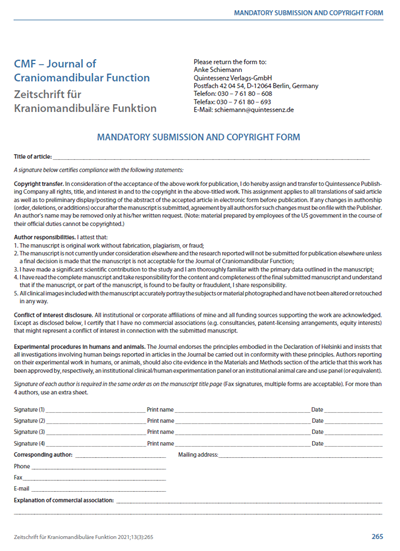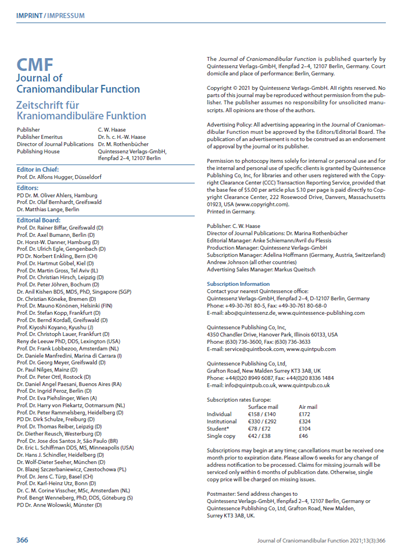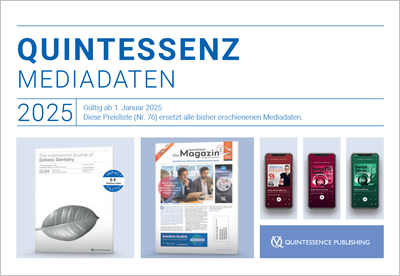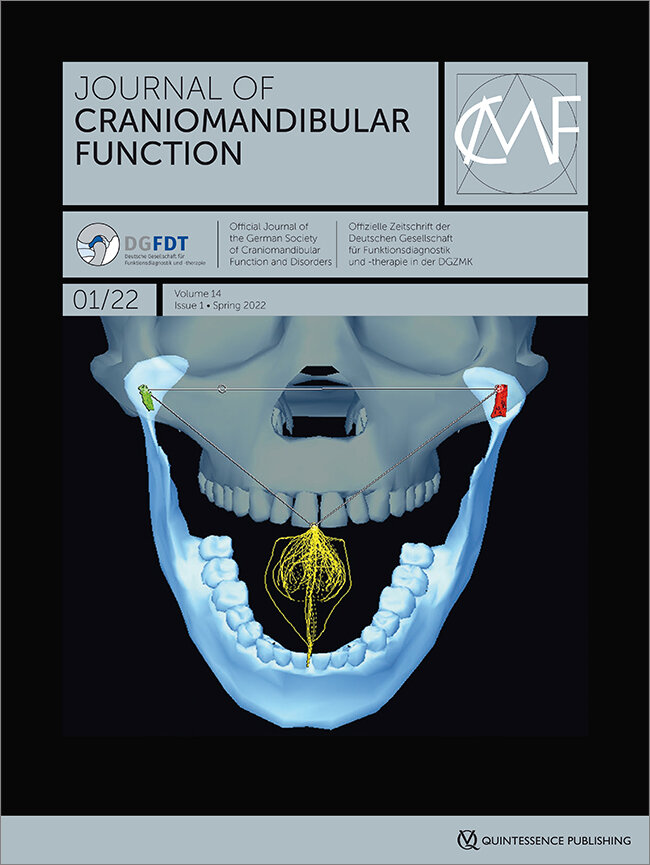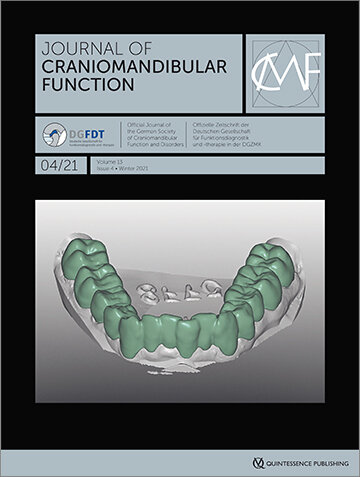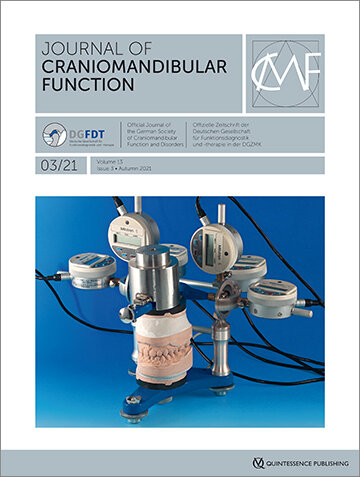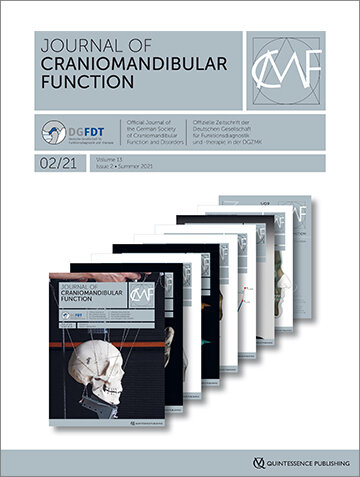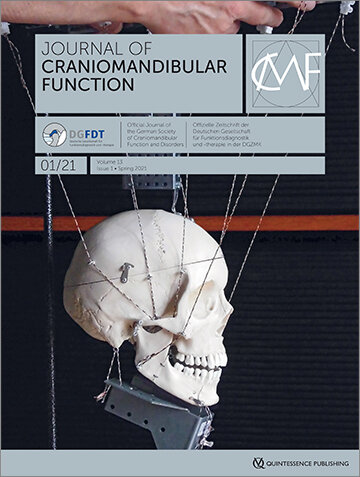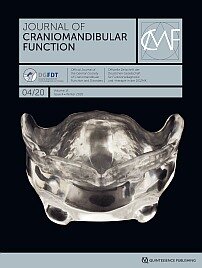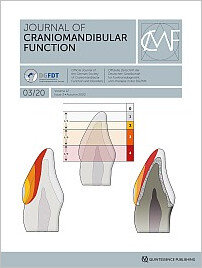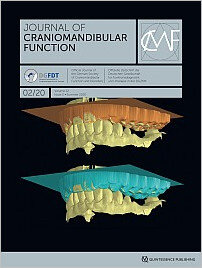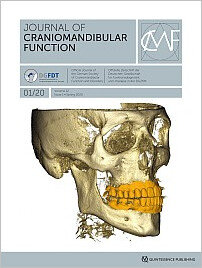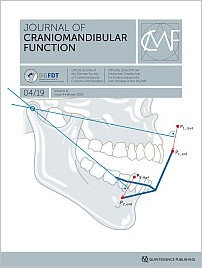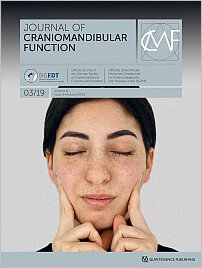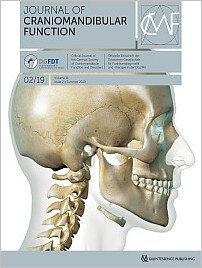SciencePages 9-23, Language: English, GermanLauenstein, Niklas D. / Becker, Giuliana M. / Bernhardt, OlafA follow-up studyAim: The objective of the present study was to investigate the effect of biofeedback treatment, administered via contingent electrical stimulation (CES) with the GrindCare 4 device (market launch in 2016), on bruxism activity and orofacial pain in patients with temporomandibular disorders (TMD) and bruxism.
Materials and methods: Twenty-six participants were enrolled in this follow-up study. The first 13 (group 1) completed a 21-day study protocol. The next 13 (group 2) were assigned a 42-day protocol, which 10 participants completed successfully. The study was conducted in three phases. In phase 1 (pretreatment), participants received baseline functional status (Research Diagnostic Criteria for Temporomandibular Disorders [RDC/TMD] questionnaire and clinical examination) and bruxism status examinations (Lange & Bernhardt Bruxism Status screener) and were then supplied with study information and a GrindCare 4 device, with oral and written instructions for its use. Per protocol, participants were directed to use the device without biofeedback on the first 4 or 7 nights, respectively, for a baseline measurement of jaw muscle contraction frequency. In phase 2 (treatment), they were to activate the device’s biofeedback mode and administer themselves after 2 to 4 weeks, respectively, of CES treatment. In phase 3 (posttreatment), group 1 and 2 participants used GrindCare 4 without biofeedback on 3 or 7 nights, respectively, for follow-up measurement and evaluation of jaw muscle contraction frequency, followed by a second functional status assessment (RDC/TMD questionnaire and clinical examination).
Results: A significant reduction of bruxism events was only achieved after 4 weeks of CES (42-day study protocol): compared with pretreatment measurements (baseline), the number of bruxism events was 40% lower after 4 weeks of treatment and 32% lower during posttreatment follow-up. The number of painful palpation sites decreased significantly in both groups (21-day arm: P = 0.010; 42-day arm: P = 0.035). However, no significant change in pain intensity was detected.
Conclusions: A 2-week CES intervention appears to be insufficient because a reduction of bruxism events only occurred after a longer treatment duration. The reduction of bruxism events achieved by 4 weeks of CES persisted into the posttreatment follow-up phase, suggestive of a potential learning effect. No evidence was found of a reduction of bruxism symptoms. At the time of publication, the manufacturer had withdrawn the study device from the market for modification. Further controlled studies with larger cohorts are needed to verify these results. A longer treatment duration and follow-up would be advisable.
Keywords: temporomandibular disorders (TMD), sleep bruxism, myofascial pain, biofeedback
SciencePages 25-34, Language: English, GermanManfredini, Daniele / Lombardo, Luca / Visentin, Alessandra / Arreghini, Angela / Siciliani, GiuseppeAn electromyographic studyAims: To assess the correlation between tooth wear and sleep-time masseter muscle activity (sMMA) in a group of healthy young adults who underwent home electromyographic/electrocardiographic (EMG/ECG) recordings with a portable device.
Methods: A total of 41 healthy volunteers (23 women, 18 men; mean age 28.8 years, range 25 to 40) with good natural dentition underwent a 2-night in-home evaluation with a portable device that allowed a simultaneous sleep-time recording of EMG signals from both masseter muscles and heart rate. The number of sleep bruxism (SB) episodes per sleep hour (SB index); the number of phasic, tonic, and mixed sMMA events per hour; and the total number of sMMA events per night were calculated. All individuals also underwent an assessment of tooth wear on digital casts with the adoption of a six-degree rating scale. Correlations between sMMA variables and tooth wear were assessed using the Pearson test. The null hypothesis was that correlation between the two conditions would not be significant.
Results: On average, the SB index was 4.5 ± 2.6, while the total number of sleep-time masseter contractions was 97.2 ± 55.2. Of those contractions, almost 60% were phasic. Average tooth wear was 1.5 ± 0.7, with the canines and mandibular incisors showing the highest wear scores. For all pairwise analyses, correlation values were not significant (P values 0.11 to 0.69), with r values ranging from 0.064 to 0.253.
Conclusion: The null hypothesis of an absence of correlation between tooth wear and sMMA could not be rejected, implying that tooth wear cannot be used as an indicator of ongoing SB or sMMA. Future studies taking into account the multifaceted nature of tooth wear and the complex natural course of sleep phenomena are encouraged to investigate the issue further, at the individual level. J Oral Facial Pain Headache 2019;33:199–204. doi: 10.11607/ofph.2081
Keywords: electromyography, masticatory muscles activity, sleep bruxism, tooth wear
SciencePages 35-46, Language: English, GermanPeroz, Ingrid / Roneh, EhssanObjectives: The centric relation (CR) before and after a single physiotherapy session in patients with myalgia and controls without craniomandibular disorders (CMD) was compared using a controlled clinical trial.
Materials and methods: Twenty-two patients diagnosed with myalgia according to the Diagnostic Criteria for Temporomandibular Disorders were included. Five controls showed no symptoms of CMD. All participants were seated on an Orthas chair. The CR was determined with an intraoral process registration (IPR) electronic central bearing device using three methods: a) The adduction point before deprogramming (AP); b) The adduction point after deprogramming by movements on the registration sensor (APD); and c) The manually (hand-)guided centric relation (CRM). Immediately after the first IPR, the participants underwent a physiotherapy session, followed by a second IPR. Cronbach’s α was used as a measurement for internal consistency to evaluate the repeatability of the IPR and the registration methods. The t test was used to analyze the measurable differences between the CR positions of the patients with myalgia and the controls without CMD before and after physiotherapy. Physiotherapy included manual techniques such as massage; stretching; and mobilization of the soft tissue, the temporomandibular joint, and the upper cervical joints.
Results: The internal consistency of all CR methods varied from acceptable for APD (0.65 ≤ α ≤ 0.99) to excellent for AD and CRM (0.79 ≤ α ≤ 0.99). The CR position did not differ significantly in patients before and after physiotherapy (P > 0.05). In controls without CMD, the APD after physiotherapy was significantly more anterior (P = 0.001).
Conclusion: A single physiotherapy session could not change the CR in patients with myalgia.
Keywords: maxillomandibular relation, relaxation, manual therapy, IPR, Gothic arch, deprogramming
Pages 47-63, Language: English, GermanRaff, AlexanderBimaxillary splints are oral appliances with a number of established dental indications, and their names vary depending on the indication (eg, anti-snoring splint, sleep apnea appliance, and positioning splint versus simulation splint). These treatment appliances are an integral part of modern dentistry and are recognized in various guidelines and scientific publications. Nevertheless, they are not yet included in Germany’s official Dental Fee Schedule (GOZ), and several new resolutions on this subject have been passed in recent months. The aim of the present article is to present and discuss these guidelines and resolutions in the scope of a critical discourse.
Keywords: occlusal splints, bimaxillary positioning splints, mandibular protrusion splints, bimaxillary simulation splints, sleep apnea, snoring, arthropathy








